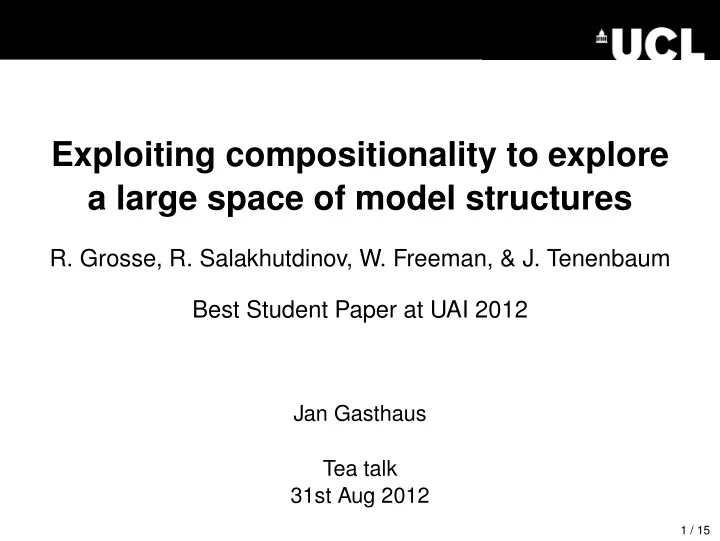

Exploiting compositionality to explore a large space of model structures R. Grosse, R. Salakhutdinov, W. Freeman, & J. Tenenbaum Best Student Paper at UAI 2012 Jan Gasthaus Tea talk 31st Aug 2012 1 / 15
Motivation Goal: Given a data set, determine the right model to use for that data set 2 / 15
Motivation Goal: Given a data set, determine the right model to use for that data set Ideal approach ◮ Implement all models ever published 2 / 15
Motivation Goal: Given a data set, determine the right model to use for that data set Ideal approach ◮ Implement all models ever published ◮ Fit them to the data set 2 / 15
Motivation Goal: Given a data set, determine the right model to use for that data set Ideal approach ◮ Implement all models ever published ◮ Fit them to the data set ◮ Compare them using some model selection criterion and pick the best 2 / 15
Motivation Goal: Given a data set, determine the right model to use for that data set Ideal approach ◮ Implement all models ever published ◮ Fit them to the data set ◮ Compare them using some model selection criterion and pick the best Mainly a computational problem; Proposed solution: 2 / 15
Motivation Goal: Given a data set, determine the right model to use for that data set Ideal approach ◮ Implement all models ever published ◮ Fit them to the data set ◮ Compare them using some model selection criterion and pick the best Mainly a computational problem; Proposed solution: ◮ Pick a rich class of models: matrix decomposition models 2 / 15
Motivation Goal: Given a data set, determine the right model to use for that data set Ideal approach ◮ Implement all models ever published ◮ Fit them to the data set ◮ Compare them using some model selection criterion and pick the best Mainly a computational problem; Proposed solution: ◮ Pick a rich class of models: matrix decomposition models ◮ Fit more complex models re-using computations from simple ones 2 / 15
Motivation Goal: Given a data set, determine the right model to use for that data set Ideal approach ◮ Implement all models ever published ◮ Fit them to the data set ◮ Compare them using some model selection criterion and pick the best Mainly a computational problem; Proposed solution: ◮ Pick a rich class of models: matrix decomposition models ◮ Fit more complex models re-using computations from simple ones ◮ Approximate model selection criterion 2 / 15
Motivation Goal: Given a data set, determine the right model to use for that data set Ideal approach ◮ Implement all models ever published ◮ Fit them to the data set ◮ Compare them using some model selection criterion and pick the best Mainly a computational problem; Proposed solution: ◮ Pick a rich class of models: matrix decomposition models ◮ Fit more complex models re-using computations from simple ones ◮ Approximate model selection criterion ◮ Greedy heuristic for exploring the space of structure exploiting compositionality 2 / 15
In A Nutshell Grammar for generative models for matrix factorization ◮ Express models as algebraic expressions such as MG + G ◮ Devise CFG that generates these expressions with rules like G → GG + G Search over model structures greedily by applying the production rules and using an approximate lower bound on model score Initialize sampling in model by using a specialized algorithm for each production rule 3 / 15
Components 4 / 15
Grammar 5 / 15
Models 6 / 15
Inference: Individual Models Initialize state using one-shot algorithm for each rule application Latent dimensionality is determined during initialization using BNP Then run simple Gibbs sampler (no details provided . . . ) 7 / 15
Initialization 8 / 15
Scoring Candidate Structures Criterion used: predictive likelihood of held-out rows and columns ◮ Marginal likelihood not feasible ◮ MSE not selective enough Use a (stochastic) lower bound on predictive likelihood, computed using a variational approximation combined with annealed importance sampling (this is about as much detail as is in the paper . . . ) 9 / 15
Search Over Structures Greedy search following grammar Start with G 1 Expand using all possible rules 2 Fit & score models 3 Keep top K models 4 Go to 2 5 Assumes that good simple models will lead to good more complex models when refined Assumption seems to be warranted: K = 3 yields the same results as K = 1 in experiments 10 / 15
Results on Synthetic Data 11 / 15
Results on Real Data 12 / 15
Results on Real Data 13 / 15
Results on Real Data 14 / 15
Computing Predictive Likelihood 15 / 15
Recommend
More recommend